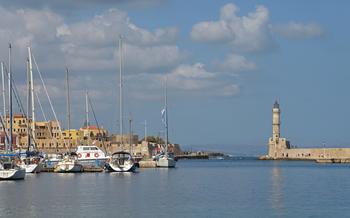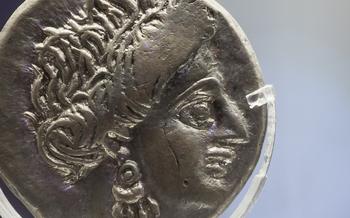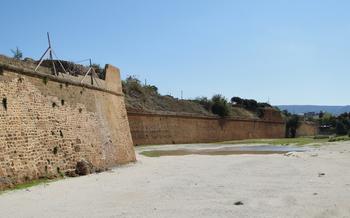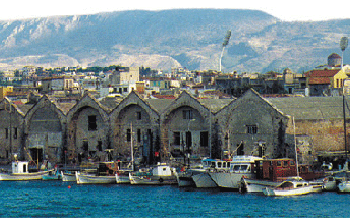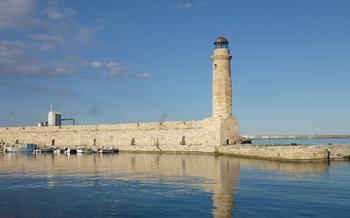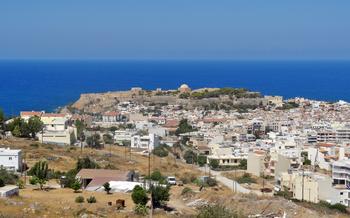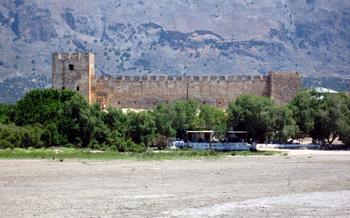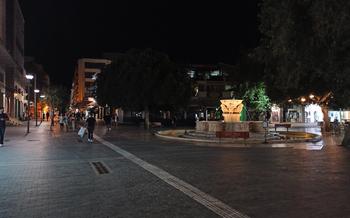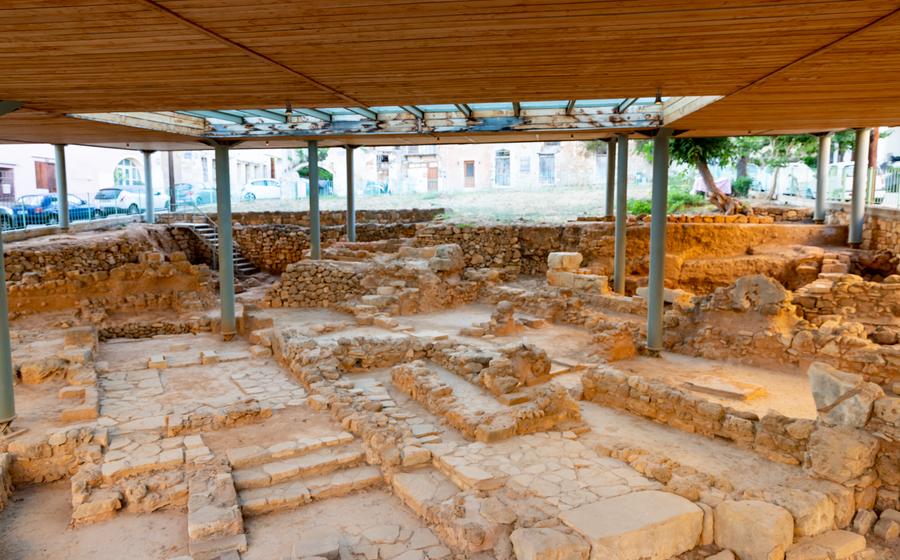
The Byzantine Wall
- A Venetian Masterpiece
- Walking on Top of History
- A Gateway to the Old Town
- Fortification Against Pirates and Invaders
- Exploring the Arsenals
- The Story of the Rethymno Gate
- The Venetian Lighthouse
- A Haven for Nature Lovers
- The Venetian Fort
- Exploring the Neighborhood
- A Place for Reflection and Remembrance
- Events and Festivals
- Getting There
- Best Time to Visit
- Insider Tip: Uncovering the Secret Tunnel
A Venetian Masterpiece
The Byzantine Wall of Chania, a testament to Venetian architectural prowess, stands as a symbol of the city's rich history and enduring resilience. Erected in the 16th century during the Venetian era, the wall served as a formidable defense against invaders, protecting the city from pirate raids and Ottoman attacks. Its strategic location, encircling the old town and harbor, made Chania a virtually impregnable fortress.
The wall's construction showcased the Venetians' mastery of military engineering. Its massive fortifications, featuring thick stone walls, imposing towers, and intricate bastions, reflected the city's importance as a strategic stronghold. The wall's design allowed for multiple lines of defense, enabling the defenders to repel attacks from various angles.
Despite the passage of time and the ravages of war, the Byzantine Wall has survived remarkably well. Meticulously restored in recent years, it stands as a testament to the enduring legacy of Venetian rule in Chania. Today, visitors can marvel at this architectural masterpiece and immerse themselves in the history that seeps from its ancient stones.
Walking on Top of History
Strolling along the ramparts of the Byzantine Wall is a captivating experience that transports you back in time. As you walk on the ancient stones, you can almost hear the echoes of the footsteps of Venetian soldiers who once patrolled these fortifications. The panoramic views of the city from the ramparts are breathtaking, offering a unique perspective of Chania's rooftops, harbor, and the vast expanse of the sea beyond.
Exploring the Byzantine Wall feels like stepping into a different era. The imposing stone walls, the narrow passages, and the strategically placed towers create an atmosphere that is both awe-inspiring and immersive. As you walk along the ramparts, you can't help but imagine the battles and sieges that took place here centuries ago.
Despite its historical significance, the Byzantine Wall remains a safe and accessible attraction for visitors. Well-maintained paths and safety measures ensure that you can explore the ramparts without any concerns. Whether you're a history buff, an architecture enthusiast, or simply someone who enjoys breathtaking views, a walk on top of the Byzantine Wall is an unforgettable experience that should not be missed.
A Gateway to the Old Town
The Byzantine Wall stands as a testament to the city's rich history, serving as both a defensive barrier and a gateway to the vibrant Old Town of Chania. The wall's connection to the harbor, once a bustling hub of maritime activity, is palpable, with the imposing structure guarding the entrance to the city.
The main entrance to the city, known as the Rethymno Gate, still stands as a grand portal, inviting visitors to step back in time and explore the historical heart of Chania. Passing through this gate is like embarking on a journey into another era, where the narrow, cobbled streets and charming Venetian buildings transport visitors to a world of old-world charm and timeless beauty.
The transition from the modern part of Chania to the historical old town is seamless, with the wall serving as a bridge between the two distinct worlds. The atmosphere shifts as visitors step through the gate, with the sounds of the city fading away and the tranquility of the old town enveloping them. The air is filled with the scent of jasmine and bougainvillea, and the gentle sound of footsteps echoes off the ancient stone walls.
Exploring the old town is like stepping into a living museum, with every corner revealing another hidden gem. Visitors can wander through the labyrinthine streets, discovering charming shops selling traditional handicrafts, cozy tavernas serving delicious Cretan cuisine, and hidden courtyards filled with flowers and the sound of birdsong.
The atmosphere in the old town is one of tranquility and timeless charm, where visitors can escape the hustle and bustle of modern life and immerse themselves in the rich history and culture of Chania. The Byzantine Wall, standing as a silent guardian, invites visitors to explore the treasures that lie within the old town's walls and experience the magic of this enchanting place.
Fortification Against Pirates and Invaders
The Byzantine Wall played a crucial role in defending Chania against pirate raids and Ottoman attacks. The city's strategic location made it a prime target for seafaring raiders, who frequently launched assaults from the nearby island of Crete. The sturdy fortifications of the wall, along with the city's natural harbor, provided a formidable defense against these attacks.
The effectiveness of the fortifications was evident during the numerous sieges that Chania faced throughout its history. In 1538, the city successfully repelled a major Ottoman invasion, thanks in large part to the strength of its walls. The Ottomans returned in 1645, but were again unable to breach the city's defenses.
The legacy of the wall as a symbol of resilience is still evident today. Despite centuries of wear and tear, the wall remains standing as a testament to the ingenuity and determination of the people of Chania. It serves as a reminder of the city's rich history and its ability to withstand adversity.
Exploring the Arsenals
The arsenals, once used for storing weapons and supplies for the Venetian navy, are an integral part of the Byzantine Wall. These impressive structures, with their grand arches and Venetian architectural style, provide a glimpse into the city's maritime past. Today, the arsenals have been transformed into a vibrant cultural center, hosting art exhibitions, concerts, and other events. The atmosphere in this area is electric, with locals and visitors alike enjoying the lively ambiance and the many cultural offerings.
The Story of the Rethymno Gate
At the northwestern corner of the Byzantine Wall stands the Rethymno Gate, a magnificent gatehouse that served as the main entrance to the city from the west. Constructed in the 16th century, the gate features a large arched opening flanked by two sturdy towers. The gate's name derives from the Cretan city of Rethymno, which lies to the west of Chania.
The Rethymno Gate is a splendid example of Venetian military architecture, with its massive walls, intricate carvings, and imposing presence. The gate is adorned with the winged lion of Saint Mark, the symbol of the Venetian Republic, and an inscription in Latin that reads: "Senatus Populusque Cretensis" (The Senate and People of Crete).
The gate played a crucial role in defending the city from invaders, as it was the only land entrance to Chania from the west. The gate was heavily fortified, with thick walls, a drawbridge, and a portcullis. It was also equipped with cannons and other weapons to repel attackers.
Today, the Rethymno Gate stands as a testament to the city's rich history and its Venetian heritage. The gate has been carefully restored and is open to visitors, who can climb to the top of the towers for stunning views of the city and the surrounding countryside. The Rethymno Gate is a must-see for anyone interested in the history and culture of Chania.
The Venetian Lighthouse
The Venetian lighthouse, an iconic landmark of Chania, stands proudly at the harbor's entrance, guiding ships safely into the port for centuries. Erected by the Venetians in the 16th century, this majestic lighthouse has weathered the storms of time, bearing witness to the city's rich maritime history.
Its cylindrical structure, topped by a lantern and a gallery, exudes an aura of timeless elegance. The lighthouse's strategic position at the tip of the old harbor ensures that it remains a crucial navigational aid, guiding vessels through the treacherous waters of the Cretan Sea.
Initially powered by oil lamps, the lighthouse underwent modernization in the 19th century when it was equipped with a state-of-the-art Fresnel lens, enhancing its visibility and range. Today, the lighthouse continues to serve as an active navigational aid, emitting a powerful beam of light that can be seen from miles away.
Beyond its practical function, the Venetian lighthouse holds immense cultural and historical significance. It stands as a testament to the ingenuity and maritime prowess of the Venetians, who transformed Chania into a thriving port city. The lighthouse has become an integral part of the city's skyline, a symbol of resilience and a beacon of hope for seafarers.
A Haven for Nature Lovers
The Venetian Wall is not only a historical and architectural masterpiece but also a haven for nature lovers. Along the ramparts, visitors can spot a diverse array of flora and fauna, including several rare and endangered species. The presence of these plants and animals highlights the importance of the wall as a natural habitat, providing shelter and sustenance to a variety of organisms.
Conservation efforts are underway to protect the wall's unique ecosystem, ensuring that future generations can continue to enjoy its natural beauty. These efforts include the establishment of protected areas, the implementation of sustainable management practices, and the monitoring of plant and animal populations.
The Venetian Fort
The Venetian Fort, also known as Firkas Fortress, stands as a testament to Chania's rich history and strategic importance. Built by the Venetians in the 16th century, the fort played a crucial role in defending the city against invaders. Its impressive fortifications, including thick walls, towers, and bastions, showcase the advanced military engineering of the time.
The fort's strategic location at the entrance to the harbor made it a formidable barrier against enemy ships. Its cannons commanded a wide range of fire, protecting the city from seaborne attacks. The fort also served as a garrison for Venetian troops, providing a secure base for military operations.
Over the centuries, the fort has witnessed numerous battles and sieges, each leaving its mark on the structure. The scars of battle are still visible on the fort's walls, a reminder of the fierce struggles that took place here.
Today, the Venetian Fort stands as a proud symbol of Chania's resilience and its rich Venetian heritage. It has been carefully restored and now houses the Maritime Museum of Crete, which showcases the island's maritime history and traditions. Visitors can explore the fort's ramparts, admire its architectural features, and learn about its fascinating past.
The Venetian Fort offers a unique perspective on Chania's history and culture. It is a must-see attraction for anyone interested in exploring the city's rich heritage and its role as a strategic stronghold in the Mediterranean.
Exploring the Neighborhood
The Byzantine Wall is not just a historical monument but also a vibrant neighborhood that invites exploration. As you wander along the wall, take some time to delve into the narrow streets and alleys that surround it. These charming lanes are lined with traditional buildings, many of which have been restored to their former glory. The ground floors of these buildings are often occupied by local shops and tavernas, where you can find everything from handmade souvenirs to delicious Cretan cuisine. The atmosphere in this neighborhood is lively and welcoming, with locals and tourists alike strolling the streets and enjoying the sights and sounds of this historic part of the city.
A Place for Reflection and Remembrance
As you wander along the Byzantine Wall, you can't help but feel a sense of awe and reverence for those who lost their lives defending this city. The wall is a living memorial to their bravery and sacrifice, and there are several inscriptions and monuments dedicated to their memory. Take a moment to pause and reflect on the sacrifices they made to protect their homeland. The atmosphere here is serene and peaceful, inviting you to pay tribute to the city's rich history. It's a place where you can honor the fallen and gain a deeper appreciation for the struggles and triumphs that have shaped Chania's identity.
Events and Festivals
The Byzantine Wall is not only a historical monument but also a vibrant venue for various events and festivals throughout the year. These events celebrate the cultural heritage of Chania and offer visitors a chance to experience the city's unique atmosphere.
One of the most popular events is the annual Venetian Festival, held in July. The festival brings the city back to life with traditional music, dance, and costumes. The streets are adorned with Venetian flags, and the city's squares host lively performances and markets. Visitors can enjoy traditional Venetian cuisine, watch historical reenactments, and immerse themselves in the city's rich history.
Another highlight is the Chania International Film Festival, held in November. The festival showcases a diverse selection of films from around the world, with screenings held in various locations throughout the city, including the Byzantine Wall. Attendees can enjoy thought-provoking films, meet filmmakers, and participate in discussions on the art of cinema.
The wall also hosts regular art exhibitions, concerts, and theater performances. These events provide a platform for local and international artists to showcase their work and offer visitors a chance to experience the city's vibrant contemporary culture.
Whether you're interested in history, art, music, or film, there's always something happening at the Byzantine Wall. Check the local listings or ask at the tourist information center for more information about upcoming events.
Getting There
Reaching the Byzantine Wall is a breeze, whether you choose to stroll, cycle, or drive. Nestled in the heart of Chania's old town, this historical gem is just a stone's throw away from other captivating attractions. Immerse yourself in the labyrinthine streets, where every corner reveals a new treasure.
For those arriving by car, there are ample parking options in the vicinity. Simply follow the signs leading to the old town, and you'll find designated parking areas within easy walking distance of the wall.
The Byzantine Wall is also wheelchair accessible, ensuring that everyone can relish in its grandeur. Ramps and designated pathways have been thoughtfully incorporated to accommodate visitors with limited mobility.
Best Time to Visit
The best time to visit the Byzantine Wall is in the late afternoon or early evening, when the sun is setting and the city is bathed in a warm, golden light. This is the perfect time to take a leisurely stroll along the ramparts and enjoy the panoramic views of Chania. You can also catch a glimpse of the sunset over the Mediterranean Sea, a truly magical experience.
If you're visiting Chania in the summer, it's best to avoid the midday heat and visit the wall in the morning or evening. The weather is generally mild in the spring and fall, making it a great time to explore the wall and the surrounding area.
To avoid the crowds, try to visit the wall during the shoulder season (May-June and September-October). This is when the weather is still pleasant, but there are fewer tourists.
No matter when you visit, be sure to wear comfortable shoes, as you'll be doing a lot of walking. It's also a good idea to bring a camera to capture the stunning views.
Insider Tip: Uncovering the Secret Tunnel
Beyond the visible ramparts of the Byzantine Wall, a hidden gem awaits discovery—a secret tunnel that once served as a strategic passageway for Venetian soldiers. While its exact location remains a closely guarded secret, rumors whisper of an unassuming entrance concealed among the fortifications. Those who dare to venture into the tunnel will be rewarded with a glimpse into the city's rich past and a unique perspective on its intricate defense system. As you navigate the dimly lit passage, imagine the footsteps of Venetian guards echoing through the centuries, carrying messages and supplies to strategic points along the wall. The secret tunnel is a testament to the ingenuity and resourcefulness of Chania's ancient defenders, adding another layer of intrigue to this already captivating historical site.
